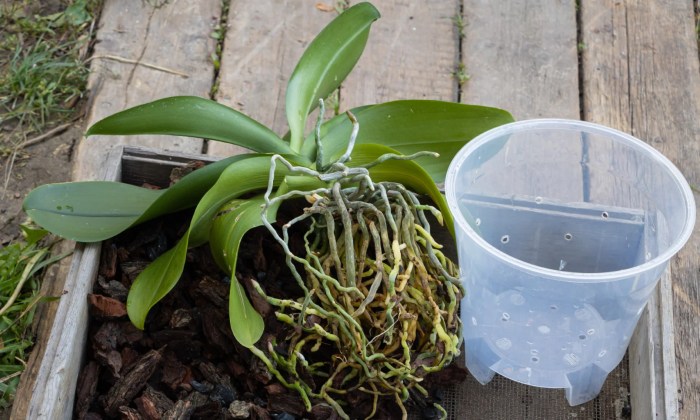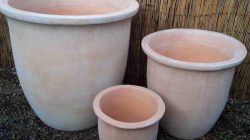Selecting and Preparing Orchids for Planting

How to plant orchids in pots – A whispered sigh, a gentle hand, the orchid’s fate rests in your care. To plant it well, a careful eye, a heart attuned to its fragile prayer. The choice of plant, a solemn task, to find a soul both strong and true, a vibrant life, a future asked, a promise whispered, old and new.
Orchid Selection
Choosing a healthy orchid is paramount to its success in its new home. A careful examination of its leaves and roots will reveal its vitality, or the subtle hints of its decline. Look for firm, plump leaves, free from blemishes, yellowing, or unusual discoloration. Avoid orchids with soft, mushy, or blackened areas, indicating disease or decay. The roots should be a silvery-green, firm to the touch.
Avoid orchids with brown, shriveled, or excessively dry roots, a sign of dehydration or root rot. A healthy orchid, a vibrant green, a hopeful sign, a life to glean.
Removing the Orchid from its Container
The act of removal, a delicate dance, a cautious touch, a gentle grace. To free the orchid from its past embrace, without a scar upon its face. Begin by gently loosening the potting medium around the base of the plant. This can often be accomplished by gently squeezing the sides of the pot, encouraging the medium to separate from the roots.
Once loosened, carefully invert the pot, supporting the orchid with your other hand. Gently tap the pot’s base to encourage the plant to slide out. Avoid pulling or tugging on the plant, as this can easily damage the roots. The slow release, a quiet plea, to set it free, and let it be.
Successfully potting orchids involves selecting the right medium and ensuring adequate drainage. However, before you even think about the potting mix, you must first grapple with the existential question of pot size; a crucial factor often overlooked. For a comprehensive guide on choosing the perfect vessel for your precious blooms, consult this invaluable resource: plant pot size guide.
Proper pot selection, as this guide will illuminate, is the cornerstone of a thriving orchid, preventing both root rot and overcrowding.
Root Inspection and Trimming
With the orchid freed, a moment’s pause, a silent prayer, a whispered cause. Inspect the roots with a discerning eye, for hidden wounds that may lie nigh. Remove any dead, decaying, or mushy roots with clean, sharp shears. Cut back to healthy, firm tissue. Avoid leaving ragged edges, which can invite infection.
Clean the shears with rubbing alcohol between each cut to prevent the spread of disease. The careful cut, a healing art, to mend the soul, and play a part.
Planting the Orchid
A fragile dance, a whispered plea, the orchid’s roots, a sight to see. Into the pot, a gentle hand, a new beginning, in this promised land. The careful placement, a somber art, a hopeful prayer, a brand new start.
Planting an orchid requires a delicate touch, a respect for its ethereal nature. Each step must be performed with mindful precision, mirroring the orchid’s own quiet strength. The right pot, the perfect medium, a harmonious blend for a life sustained.
Orchid Placement and Potting Medium
The placement of the orchid’s roots is crucial for its well-being. A crowded pot suffocates, while a too-loose fit leaves it vulnerable. The roots, like delicate veins, need space to breathe, to drink, to thrive.
Imagine a delicate, ethereal being, nestled gently in its new home. Its roots, a network of fine threads, should be spread evenly around the pot’s perimeter, avoiding bunching or crowding. The roots should be neither compressed nor stretched. A balanced distribution ensures optimal airflow and water penetration.
Visual Representation:
Imagine a circle representing the pot. The orchid’s roots, like thin, silver threads, spread outward from the center, reaching the edge of the circle, but not overlapping or tightly bunched. There should be some space between each root, allowing for air circulation.
The potting medium should be airy and well-draining, allowing excess water to escape freely, preventing root rot. A blend of bark chips, perlite, and charcoal often works well, providing both drainage and moisture retention. Avoid using soil, as it retains too much moisture.
Watering the Newly Planted Orchid
The first watering after planting is a pivotal moment, a baptism of sorts for the delicate transplant. Too much, and the roots drown; too little, and they wither. The balance, as always, is key.
Water gently, allowing the water to soak into the medium thoroughly. Avoid overwatering, which can lead to root rot. It’s better to underwater slightly than to overwater. Observe the potting mix; water only when it feels dry to the touch. The frequency will depend on the environment – a warmer, drier climate will require more frequent watering than a cool, humid one.
A light misting can also help to maintain humidity, particularly in drier conditions.
Post-Planting Care: How To Plant Orchids In Pots

A fragile bloom, a whispered sigh, the orchid’s life, a fleeting try. Careful tending, gentle hand, to nurture life across the land. The journey’s not yet fully flown, for after planting, it’s still alone. Observe its needs, attend with care, to banish shadows, ease despair.Watering schedules, a delicate dance, too much, too little, a mournful chance. Fertilizing’s touch, a subtle art, to feed its soul, and mend its heart.
Light’s embrace, a vital ray, to guide its growth, and light its way.
Watering and Fertilizing Orchids
The orchid’s thirst, a silent plea, a delicate balance, for you and me. Overwatering’s touch, a chilling blight, leaves roots ashen, robbed of light. Yellowing leaves, a mournful sign, a drowning soul, a fate malign. Conversely, thirst’s harsh, relentless hold, shrivels leaves, a story told. A schedule’s balm, a guiding star, watering deeply, yet not afar.
Once a week, a gentle pour, observing closely, evermore. During dormancy, reduce the flow, to let it rest, and softly grow. Fertilizer’s kiss, a measured feed, diluted well, to meet its need. A balanced blend, a monthly grace, enhances beauty, time and space. Avoid overfeeding, a cautious hand, for burnt roots cry across the land.
Light and Air Circulation
Sunlight’s kiss, a gentle gleam, not scorching rays, a painful dream. Bright, indirect light, a nurturing grace, to paint its petals, time and space. East or west-facing windows’ light, a perfect haven, day and night. Air circulation, a vital key, to prevent rot, for all to see. A gentle breeze, a whispered prayer, to ward off fungus, and despair.
Good air flow prevents moisture build-up, which leads to fungal and bacterial diseases. A fan’s soft hum, a helpful friend, promotes healthy growth without end. High humidity, a tropic dream, mimics its home, a gentle stream. Pebbles and water, a tray’s design, increases moisture, a subtle sign. Grouping plants, a humid space, creates a haven, time and space.
Addressing Issues
A wilting bloom, a heart’s distress, a sign of ailment, nonetheless. Yellowing leaves, a fading hue, a silent plea, for help from you. Root rot’s grip, a somber sight, brown, mushy roots, devoid of light. Repotting’s task, a careful art, to save the orchid, mend its heart. Pruning’s touch, a gentle hand, removes the damaged, across the land.
Careful observation, a watchful eye, to catch the issues, before they cry. Prevention’s grace, a mindful deed, to safeguard health, and plant the seed.
Troubleshooting Common Problems
A fragile bloom, an orchid’s silent sigh, reflects the gardener’s heart, beneath a weeping sky. Each wilted leaf, a whispered, mournful plea, a testament to struggles, for all the world to see. Let’s delve into the mysteries of their plight, and seek to mend the damage, and restore their gentle light.
Orchid cultivation, a delicate dance between nurturing care and the plant’s inherent resilience, often presents challenges. Understanding the underlying causes of common problems is crucial for effective intervention and preventing further distress.
Root Rot
Root rot, a chilling specter haunting orchid growers, manifests as mushy, dark brown roots, often accompanied by a foul odor. Overwatering, poor drainage, and excessively humid conditions create the perfect breeding ground for harmful fungi and bacteria, leading to the decay of the root system, the orchid’s lifeblood. Solutions include repotting in well-draining media, improving air circulation, and adjusting watering practices to allow the potting mix to dry between waterings.
Preventative measures include using a well-draining potting mix specifically designed for orchids, ensuring adequate air circulation around the roots, and avoiding overhead watering, which can lead to prolonged periods of dampness. A healthy root system, a foundation of strength, is key to the orchid’s survival.
Leaf Discoloration, How to plant orchids in pots
Yellowing, browning, or spotting of leaves often signals underlying stress. Nutrient deficiencies, improper watering, pest infestations, or exposure to extreme temperatures can all contribute to leaf discoloration. A pale, yellowing leaf might suggest a lack of nutrients, while brown tips often indicate overwatering or insufficient humidity. Solutions vary depending on the cause; for nutrient deficiencies, a balanced orchid fertilizer can be beneficial.
For overwatering, adjusting watering schedules is essential. Pest infestations require targeted treatment with appropriate insecticides or miticides. A careful observation of the affected leaves, a meticulous detective’s work, will reveal the underlying cause.
Stunted Growth
A slow-growing, stunted orchid often reveals a struggle for survival. Insufficient light, improper fertilization, root problems, or disease can all hinder the plant’s growth. Weak, spindly stems and small, underdeveloped leaves are telltale signs. Solutions involve providing adequate light (but avoiding direct sunlight), using a balanced fertilizer, addressing any root issues, and treating any underlying diseases. A vibrant, flourishing orchid, a testament to careful tending, is a reward for diligent care.
FAQ Explained
What if my orchid’s leaves are turning yellow?
Yellowing leaves can mean overwatering, underwatering, or insufficient light. Check your watering schedule and light exposure. If the roots are mushy, you’re overwatering. If they’re dry and brittle, you’re underwatering.
How often should I fertilize my orchid?
Fertilize your orchid every 2-4 weeks during the growing season (spring and summer) with a balanced orchid fertilizer diluted to half strength. Reduce or stop fertilizing during the dormant period (fall and winter).
Can I use regular potting soil for orchids?
Nope! Regular potting soil retains too much moisture and lacks the aeration orchids need. Use a well-draining orchid potting mix instead.
My orchid isn’t blooming. What gives?
Orchids need specific light and temperature conditions to bloom. Make sure your orchid is getting enough bright, indirect light and that the temperature is appropriate for its type. Sometimes, they just need time!






